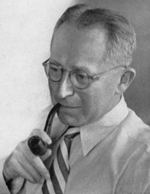Adriaan van Maanen facts for kids
Quick facts for kids
Adriaan van Maanen
|
|
|---|---|
 |
|
| Born | March 31, 1884 Sneek, Netherlands
|
| Died | January 26, 1946 (aged 61) Pasadena, California, United States
|
| Alma mater | University of Utrecht |
| Known for | Van Maanen's star |
| Scientific career | |
| Fields | Astronomy |
| Institutions | |
| Doctoral advisor | Albertus Antonie Nijland |
Adriaan van Maanen (March 31, 1884 – January 26, 1946) was an important astronomer from the Netherlands who later became an American citizen. He was born in Friesland.
He studied astronomy at the University of Utrecht, earning his Ph.D. in 1911. After that, he worked for a short time at the University of Groningen. In 1911, he moved to the United States. He started as a volunteer at Yerkes Observatory.
Within a year, he got a job at the Mount Wilson Observatory. He worked there until he passed away in 1946. In 1924, Van Maanen became a member of the Royal Netherlands Academy of Arts and Sciences.
Contents
Van Maanen's Discoveries and the Great Debate
Adriaan van Maanen is known for his work on "spiral nebulae." These were what we now call galaxies with spiral shapes. He believed these spiral nebulae were inside our own Milky Way galaxy.
Measuring Spiral Nebulae
Van Maanen used special tools to measure the movements within these spiral nebulae. He thought he saw their spiral arms rotating. These measurements supported the idea that they were close by.
However, his findings did not match what another famous astronomer, Edwin Hubble, discovered. Hubble found that the Andromeda Nebula and other spiral nebulae were actually very far away. They were outside our Milky Way.
If Hubble was right, the speeds Van Maanen calculated for the nebulae's rotation would mean parts of them were moving faster than light. This is impossible according to the laws of physics. Later, it was found that Van Maanen's measurements were incorrect.
The Great Debate in Astronomy
In the early 1900s, astronomers had a big argument about the size of the universe. They also wondered if spiral nebulae were inside or outside our galaxy. This argument is known as the Great Debate. It happened in April 1920.
Two main astronomers, Harlow Shapley and Heber Doust Curtis, led this debate. Shapley thought spiral galaxies were close objects within the Milky Way. He used Van Maanen's measurements to support his view. Van Maanen had claimed the spiral arms rotated in about 100,000 years.
Curtis, on the other hand, believed spiral galaxies were like our Milky Way. He thought they were huge and far away. If Van Maanen's rotation speeds were correct, it would mean the spiral arms were moving faster than light. Curtis did not believe Van Maanen's results.
Why Van Maanen's Measurements Were Wrong
Later, other astronomers looked closely at Van Maanen's work. They found that he had made a serious mistake.
How the Error Happened
Van Maanen used a tool called a stereo blink comparator. This tool helped him compare old photos of the sky with new ones. By quickly switching between the two photos, he could spot tiny changes in the positions of stars.
He used stars near the edges of his photos as reference points. But he did not realize that the telescope's lenses caused small distortions. These distortions slightly changed where the stars appeared to be. This led to "imaginary movements" that weren't real.
Confirmation Bias
Another reason for the error might have been something called confirmation bias. At that time, many astronomers believed that "spiral nebulae" were close by. They also thought these nebulae should show some rotation.
So, when Van Maanen's results seemed to confirm this idea, they might not have been checked as carefully. If his results had shown something completely different, they might have been looked at more closely.
See also
 In Spanish: Adriaan van Maanen para niños
In Spanish: Adriaan van Maanen para niños

